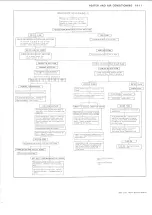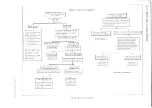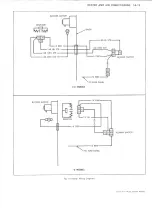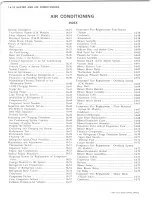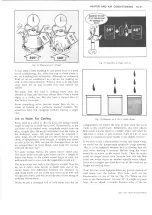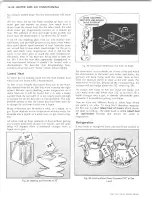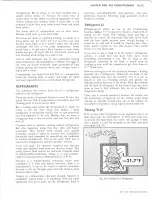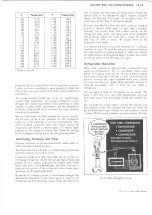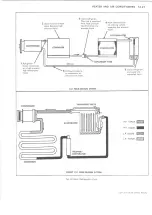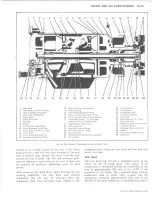
HEATER AND AIR C O N D IT I O N IN G
1A-25
°F
Pressure (psi)
°F
Pressure (psi)
-4 0
11
.
0
*
+
50
46.7
- 3 5
8
.
3
*
+
55
52.0
-3 0
5
.
5
*
+
60
57.7
-2 5
2
.
3
*
+
65
63.7
- 2 0
0.6
+
70
70.1
-
15
2.4
+
75
76.9
-
10
4.5
+
80
84.1
-
5
6.8
+
85
91.7
0
9.2
+
90
99.6
+
5
11.8
+
95
108.1
+
10
14.7
+
100
116.9
+
15
17.7
+
105
126.2
+
20
21.1
+
110
136.0
+
25
24.6
+
115
146.5
+
30
28.5
+
120
157.1
+
32
30.1
+
125
167.5
+
35
32.6
+
130
179.0
+
40
37.0
+
140
204.5
+
45
41.7
+
150
232.0
In c h e s o f V a c u u m
pump the air in, it would leak out through the puncture.
Unless you have something to push against—to block the
flow of air—you can’t create more than a mere semblance
of pressure.
The same situation holds ture in an air conditioning
system. The compressor can pump refrigerant vapor
through the system, but unless it has something to push
against, it cannot build up pressure. All the compressor
would be doing would be to circulate the vapor without
increasing its pressure.
We can’t just block the flow through the system entirely.
All we want to do is put pressure on the refrigerant
vapor so it will condense at normal temperatures. This
must be done sometime after the vapor leaves the
evaporator and before it returns again as a liquid. High
pressure in the evaporator would slow down the boiling
of the refrigerant and penalize the refrigerating effect.
Controlling Pressure and Flow
Pressure and flow can be controlled with a float valve, or
with a pressure-regulating valve.
The float valve type will give us a better idea of pressure
and flow control, let’s look at it first.
It consists simply of a float that rides on the surface of
the liquid refrigerant. As the refrigerant liquid boils and
passes off as a vapor, naturally the liquid level drops
lower and lower. Correspondingly, the float, because it
rides on the surface of the refrigerant, also drops lower
and lower as the liquid goes down.
By means of a simple system of mechanical linkage, the
downward movement of the float opens a valve to let
refrigerant in. The incoming liquid raises the fluid level
and, of course, the float rides up along with it. When the
surface level of the refrigerant liquid reaches a desired
height, the float will have risen far enough to close the
valve and stop the flow of refrigerant liquid.
We have described the float and valve action as being in
a sort of definite wide open or tight shut condition.
Actually, the liquid level falls rather slowly as the
refrigerant boils away. The float goes down gradually
and gradually opens the valve just a crack. At such a
slow rate of flow, it raises the liquid level in the
evaporator very slowly.
It is easy to see how it would be possible for a stablized
condition to exist. By that, we mean a condition wherein
the valve would be opened enough to allow just exactly
the right amount of refrigerant liquid to enter the system
to take the place of that leaving as a vapor.
Refrigerator Operation
W e’ve now covered all the scientific ground-rules that
apply to refrigeration. Try to remember these main
points. All liquids soak up lots of heat without getting
any warmer when they boil into a vapor, and, we can use
pressure to make the vapor condense back into a liquid
so it can be used over again. With just that amount of
scientific knowledge, here is how we can build a
refrigerator.
We can place a flask of refrigerant in an icebox. We
know it will boil at a very cold temperature and will
draw heat away from everything inside the cabinet (fig.
32).
We can pipe the rising vapors outside the cabinet and
thus provide a way for carrying the heat out. Once we
get the heat-laden vapor outside, we can compress it with
a pump. With enough pressure, we can squeeze the heat
Fig. 32--Basic Refrigerant Circuit
LIGHT DUTY TRUCK SERVICE MANUAL
Summary of Contents for Light Duty Truck 1973
Page 1: ......
Page 4: ......
Page 6: ......
Page 53: ...HEATER AND AIR CONDITIONING 1A 27 LIGHT DUTY TRUCK SERVICE MANUAL...
Page 115: ...LIGHT DUTY TRUCK SERVICE M A N U A L HEATER AND AIR CONDITIONING 1A 89...
Page 123: ...BODY 1B 3 Fig 6 Typical 06 Van LIGHT DUTY TRUCK SERVICE MANUAL...
Page 149: ...BODY 1B 29 Fig 84 Body Mounting 06 Fig 85 Body Mounting 14 LIGHT DUTY TRUCK SERVICE MANUAL...
Page 171: ...LIGHT DUTY TRUCK SERVICE M A N U A L Fig 2 Frame Horizontal Checking Typical FRAME 2 3...
Page 173: ...LIGHT DUTY TRUCK SERVICE M A N U A L Fig 4 10 30 Series Truck Frame FRAME 2 5...
Page 174: ...2 6 FRAME LIGHT DUTY TRUCK SERVICE MANUAL Fig 5 Underbody Reference Points G Van...
Page 185: ...FRONT SUSPENSION 3 11 Fig 16 Toe out on Turns LIGHT DUTY TRUCK SERVICE MANUAL...
Page 224: ......
Page 266: ......
Page 351: ...ENGINE 6 15 Fig ID Sectional View of Eight Cylinder Engine LIGHT DUTY TRUCK SERVICE MANUAL...
Page 375: ...EN G IN E 6 39 LIGHT DUTY TRUCK SERVICE MANUAL...
Page 376: ...6 4 0 ENGINE LIGHT DUTY TRUCK SERVICE MANUAL...
Page 377: ...ENG IN E 6 41 LIGHT DUTY TRUCK SERVICE MANUAL...
Page 378: ...LIGHT DUTY TRUCK SERVICE MANUAL Fig 37L K Series Engine Front Mount 6 42 ENG INE...
Page 400: ...6 6 4 ENG INE LIGHT DUTY TRUCK SERVICE MANUAL...
Page 401: ...ENG IN E 6 65 LIGHT DUTY TRUCK SERVICE MANUAL...
Page 402: ...6 6 6 ENGINE LIGHT DUTY TRUCK SERVICE MANUAL...
Page 403: ...E NG IN E 6 67 Fig 36V C Series Engine Mounts LIGHT DUTY TRUCK SERVICE MANUAL...
Page 410: ......
Page 423: ...EN G IN E C OOLING 6K 13 Fig 16 Overheating Chart LIGHT DUTY TRUCK SERVICE MANUAL...
Page 424: ...6 K 1 4 ENG INE COOLING Fig 17 Coolant Loss Chart LIGHT DUTY TRUCK SERVICE MANUAL...
Page 456: ...6M 32 ENGINE FUEL Fig K15 Accelerator Controls G Van L 6 LIGHT DUTY TRUCK SERVICE MANUAL...
Page 492: ......
Page 512: ...Fig 18e Vacuum Advance Diagram V8 Engine...
Page 516: ...6 T 2 4 E M IS S IO N CONTROL SYSTEMS LIGHT DUTY TRUCK SERVICE MANUAL...
Page 528: ......
Page 590: ......
Page 593: ...CLUTCHES MANUAL TRANSMISSIONS 7M 3 LIGHT DUTY TRUCK SERVICE MANUAL...
Page 598: ...7M 8 CLUTCHES MANUAL TRANSMISSIONS LIGHT DUTY TRUCK SERVICE MANUAL...
Page 642: ......
Page 654: ......
Page 743: ...FUEL TANKS AND EXHAUST 8 13 LIGHT DUTY TRUCK SERVICE MANUAL...
Page 744: ...8 14 FUEL TANKS AND EXHAUST LIGHT DUTY TRUCK SERVICE MANUAL...
Page 760: ...8 30 FUEL TANKS AND EXHAUST Fig 40 Exhaust Pipe P Models LIGHT DUTY TRUCK SERVICE MANUAL...
Page 761: ...FUEL TANKS AND EXHAUST 8 31 LIGHT DUTY TRUCK SERVICE MANUAL...
Page 763: ...FUEL TANKS AND EXHAUST 8 33 LIGHT DUTY TRUCK SERVICE MANUAL...
Page 766: ......
Page 832: ...LIGHT DUTY TRUCK SERVICE MANUAL Fig 106 Power Steering Pump Mounting Typical 9 66 STEERING...
Page 833: ...PUMP ASSEMBLY STEERING GEAR TYPICAL SMALL V8 TYPICAL LARGE V8 STEERING 9 67...
Page 861: ...STEERING 9 95 Fig 134 Power Steering Pump Leakage LIGHT DUTY TRUCK SERVICE MANUAL...
Page 864: ......
Page 876: ......
Page 886: ...11 10 CHASSIS SHEET METAL LIGHT DUTY TRUCK SERVICE MANUAL...
Page 891: ...ELECTRICAL BODY AND CHASSIS 12 5 LIGHT DUTY TRUCK SERVICE MANUAL...
Page 934: ......
Page 942: ......
Page 970: ......
Page 972: ......
Page 974: ......
Page 976: ...V...
Page 978: ......
Page 979: ......

